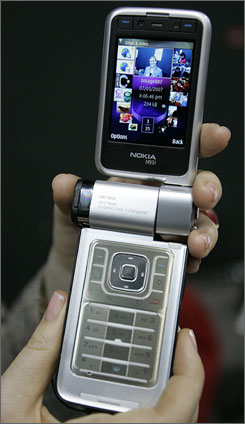| February, 2007 |  |
< Prev Page 6 Next > |
| February, 2007 |  |
< Prev Page 6 Next > |
New Search Engine for Aging Boomers
Does surfing the Web exhaust -- and even exasperate -- older people? The backers of Cranky.com are betting on it.
Cranky is a specialty search engine designed to please aging baby boomers by processing every request from the perspective of someone who is at least 50 years old.
This steadily growing demographic often feels overwhelmed using high-powered search engines from the likes of Google Inc. and Yahoo Inc. because they spew out more results than older eyes care to see, said Jeff Taylor, the Cranky mastermind who previously struck it rich as the founder of online employment site Monster.com.
"Our research found that people 50 and over are confused about searching on the Web," said Taylor, who runs Eons, a Boston-based startup devoted to creating products aimed at the graying baby-boom generation born from 1946 through 1964. "It's hard for them to understand all the results."
Launched earlier this week, Cranky is trying to simplify things by showing just four Web sites in the non-advertising section of each results page and making the sparser listings more relevant to its target audience. Google and Yahoo, by comparison, usually list at least 10 sites per results page.
Like the mainstream search engines, Cranky hopes to make money selling targeted advertising alongside its search results. Cranky's ads will be provided by InterActiveCorp's Ask.com, a search engine that has been around for a decade.
After teaming up with Internet research firm Compete Inc. to identify the 500,000 most popular Web sites among people at least 45 years old, Cranky dispatched reviewers to dig even deeper into the top 5,000 destinations. The reviewers then wrote descriptions about the content and tried to ensure the index contained more direct links to the most meaningful information.
At 46, Taylor technically isn't old enough to be using Cranky.com yet.
But he could have easily retired by now. When he left Monster in August 2005, Taylor had already made at least $33 million cashing in his stock options in the site's parent company, Monster Worldwide Inc.
Taylor isn't expecting Cranky to be an overnight success.
"By the time I get it right," he said, "I probably will be 50."
Nokia unveils new, thinner multimedia phones
 The world's largest cellphone maker,
Nokia, unveiled slim new multimedia handsets at the Las Vegas Consumer Electronics Show in an answer to stiff competition from rivals such as Motorola.
The world's largest cellphone maker,
Nokia, unveiled slim new multimedia handsets at the Las Vegas Consumer Electronics Show in an answer to stiff competition from rivals such as Motorola.
The Finnish company, which makes one in three phones sold globally, has suffered from a lack of thin models in the last two years as consumers sought slimmer phones following the success of Motorola's RAZR.
At 13.7 millimeters, the new Nokia N76 phone is as slender as most slim-line models from smaller rivals. The RAZR is 14 mm thick and lags far behind in terms of features.
Nokia plans to launch the new ultra-thin Barracuda phone later in the year, although it has not yet revealed the measurements of this offering.
"Nokia seems to have recovered with much smaller casualties from the slim phone crises than from the clam shell crises," FIM Securities' analyst Jussi Hyoty said in a note, referring to a 2004 setback when Nokia's share price halved in a few months after it lost market share to rivals offering folding models.
Nokia has been able to hang on to a global market share of around 35 percent thanks to booming demand for its cheaper models in emerging markets.
SHAVING OFF MILLIMETERS
Nokia introduced its powerful N-Series in 2005, soon after Motorola hit gold with its thin but not very powerful RAZR.
It launched a new version of its N93 -- the N93i -- that is 3 mm slimmer and doubles as a digital video camera. It will be available for 600 euros in the first quarter.
The N76 will be sold in the first quarter for around 390 euros ($511) before taxes and subsidies from operators.
The Finnish company also unveiled a new Internet tablet using the
Linux operating system. Building on Nokia's first tablet -- the 770 -- the N800 is faster, has a full-screen finger QWERTY keyboard and an integrated Web camera.
The device, which avoids time-consuming network-approval steps from mobile operators through a Wi-Fi short-range wireless Internet connection, will be available immediately in the United States and several European markets for around $400 and 400 euros respectively.
Nokia also will work with EBay's Skype to add Skype calls to the tablet by the end of the first half of 2007.
| February, 2007 |  |
< Prev Page 6 Next > |